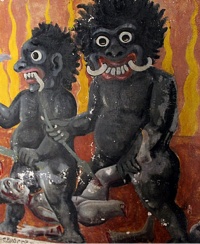Pishacha: Difference between revisions
Pablo Sender (talk | contribs) (Created page with "'''Pishacha''' (Sanskrit: पिशाच ''piśāca'', literally, "eater of raw flesh") are flesh-eating demons according to Indian mythology. Their origin is obscure, althou...") |
Pablo Sender (talk | contribs) No edit summary |
||
| Line 1: | Line 1: | ||
[[File:Pishacha.jpg|right|200px|thumb|Traditional rendering of a Pishacha]] | |||
'''Pishacha''' (Sanskrit: पिशाच ''piśāca'', literally, "eater of raw flesh") are flesh-eating demons according to Indian mythology. Their origin is obscure, although some believe that they were created by Brahma. Another legend describes them as the sons of either Krodha (figuratively "Anger") or as Dakṣa’s daughter Piśāca. They are also said to be creatures of humanity’s vices, having the power to assume different forms at will. They feed on human energies and can possess human beings and alter their thoughts. The term is occasionally used in a more general way to include all the ghosts, goblins and [[vampire]]s that haunt cemeteries and ruins in India. | '''Pishacha''' (Sanskrit: पिशाच ''piśāca'', literally, "eater of raw flesh") are flesh-eating demons according to Indian mythology. Their origin is obscure, although some believe that they were created by Brahma. Another legend describes them as the sons of either Krodha (figuratively "Anger") or as Dakṣa’s daughter Piśāca. They are also said to be creatures of humanity’s vices, having the power to assume different forms at will. They feed on human energies and can possess human beings and alter their thoughts. The term is occasionally used in a more general way to include all the ghosts, goblins and [[vampire]]s that haunt cemeteries and ruins in India. | ||
Revision as of 18:40, 26 July 2017
Pishacha (Sanskrit: पिशाच piśāca, literally, "eater of raw flesh") are flesh-eating demons according to Indian mythology. Their origin is obscure, although some believe that they were created by Brahma. Another legend describes them as the sons of either Krodha (figuratively "Anger") or as Dakṣa’s daughter Piśāca. They are also said to be creatures of humanity’s vices, having the power to assume different forms at will. They feed on human energies and can possess human beings and alter their thoughts. The term is occasionally used in a more general way to include all the ghosts, goblins and vampires that haunt cemeteries and ruins in India.
In the Theosophical view the pisachas are known as "shells", that is, the Kāmarūpa plus the remnants of the fifth principle left behind in kāmaloka after the Ego entered in devachan.
